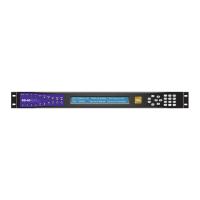
Do you have a question about the Adtec RD-60 and is the answer not in the manual?
| Model | RD-60 |
|---|---|
| Category | Media Converter |
| Video Format Support | MPEG-2, H.264 |
| MPEG Decoding | Yes |
| Input Ports | ASI, IP |
| Output Ports | HDMI |
| Supported Resolutions | 1080p |
| Audio Decoding | MPEG-1 Layer II, AAC |
| IP Input | Yes |
Provides essential safety precautions for device operation and installation.
Lists regulatory compliance information like FCC and Industry Canada.
Canadian regulatory compliance statement for digital apparatus.
Statement of conformity with EU electromagnetic compatibility directives.
Details the RD-60 models and their hardware configurations.
Describes the physical front panel and its interactive components.
Details the front panel LCD display states and feedback.
Explains the LED indicators for different demodulator models.
Describes the function of each transport LED indicator.
Explains the indicators for audio decoding status.
Details indicators for system status like alarms and network link.
Outlines the front panel controls and their operational functions.
Instructions on how to perform a device reset via the front panel.
Visual representation of the device's menu hierarchy.
Details the configuration options within the Services menu.
Allows selection of modulation mode and FEC code rate.
Configures the number of symbols transmitted per second.
Sets the frequency range for tuner acquisition.
Determines the shape of the input filter.
Option for inserting bursts of pilot tones for DVB-S2.
Selects DVB-S2 frame type for latency or protection.
Manages LNB state, polarity, and tone settings.
Manages RF configuration profiles (Save, Select, Delete).
Controls the frequency of the LNB local oscillator.
Allows manual entry of LNB Local Oscillator frequency.
Enters the L-Band frequency for calculation.
Sets the frequency range for tuner acquisition.
Determines the shape of the input filter.
Option for inserting bursts of pilot tones for DVB-S2.
Selects DVB-S2 frame type for latency or protection.
Allows selection of the modulation type.
Configures the number of symbols transmitted per second.
Input Stream Identifier for multistream applications.
Displays RF lock status and detailed information.
Sets multicast IP addresses for stream reception.
Setting address to 0.0.0.0 for unicast stream listening.
Configures connector and port number for IP reception.
Sets the SDI video fault resolution and startup behavior.
Defines output behavior when video is not detected.
Determines if SDI banks are output natively or downscaled.
Configures genlock modes, horizontal, vertical, and phase adjustments.
Shows genlock status and provides reset functionality.
Details acceptable sync input signals.
Determines how BISS encrypted streams are processed for ASI output.
Configures audio PID assignment and decoding modes.
Recommends Dolby E line placement for specifications.
Displays VBI statistics for SDI, Alt SDI, and CVBS.
Using automatic modulation and coding detection.
Using auto detection for LB modulation and symbol rate.
Guidance on using pilots for DVB-S2 under specific conditions.
Creating and loading RF configuration profiles for LB.
Using IP protocols for receiving transport streams.
Using UDP for transport streams, recommended for low packet loss.
Using RTP for reliable packet delivery and sequence identification.
Using RTP with FEC for error correction.
Using TCP for reliable, connection-based stream reception.
Setting multicast IP addresses for stream reception.
Setting address to 0.0.0.0 for unicast stream listening.
Configuring port number and connector for IP reception.
Instructions for logging into the system menu.
Sets the time frame for automatic logout.
Configures network settings like IP address and DHCP.
Defines system time, timezone, and NTP configuration.
Accesses alarm status and event logs.
Controls SNMP status and community settings.
Configures RS-232 terminal monitor settings.
Reports the currently running firmware version.
Manages permanent and temporary feature keys.
Details the function of each back panel connector.
Pinout details for the DB9-M analog audio output.
Input specifications for optional demodulator RF inputs.
Pinout details for serial adapter connections.
Overview of GPIO and Parport capabilities.
Pinout details for the GPIO port.
Pinout details for the Parport.
Describes the web-based control software application.
Instructions for connecting to the device via Ethernet.
Explains Adtec's zero-configuration networking technology.
Instructions for logging into the web-based application.
Steps to upgrade device firmware using the web interface.
Steps to upgrade demodulator firmware using the web interface.
Lists available demodulator firmware versions.
Alternative methods for firmware upgrades using FTP and Telnet.
How to upgrade unit features using temporary or permanent keys.
Procedures for entering permanent unlock keys.
Procedures for uploading temporary key files.
Lists and describes available unit feature keys.
Details the specifications for DVB-ASI, IP, and RF inputs.
Details specifications for SDI, CVBS, DVB-ASI, AES, and Analog audio outputs.
Details specifications for serial, Ethernet, parallel, and GPIO ports.
Specifications for video decode and audio formats.
Physical dimensions, power, operational, and compliance details.
Technical specifications for the Premium Demodulator.
Technical specifications for the Advanced Demodulator.
Technical specifications for the L-Band Demodulator.
Technical specifications for the Standard Demodulator.
Contact information and hours for Adtec support.
Information to provide for efficient troubleshooting.
Details different Service Level Agreement options.